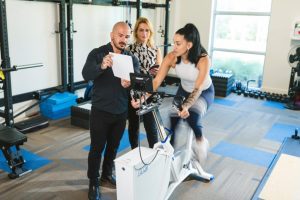|
Getting your Trinity Audio player ready...
|
If the idea of going to the gym makes you moan and groan, you’re not alone.
Let’s be honest: It’s called working out for a reason. Though incredibly good for you, exercise doesn’t always feel so good. At least, not when you’re drenched in sweat, huffing and puffing, making those involuntary (ugly) faces, and trying to concentrate on anything other than your poor, tired muscles.
Everyone has limits, of course. But many of the reasons people don’t pick up the pace or push through that “good pain” are rarely physical. They are mostly mental. Personal history and past experiences shape how much discomfort someone believes they can tolerate — and that belief often becomes a barrier. Many give up long before the body actually demands it. Worse, some avoid exercise altogether.
But each person’s individual tolerance threshold isn’t set in stone. Thanks, in part, to the brain’s neuroplasticity and ability to adapt when under pressure.
New research suggests even people with a lower subjective exercise tolerance can develop a degree of mental toughness by ‘training’ important brain networks to better cope with the inherent discomfort of exercise. According to study author Marcelo Bigliassi, this improves our ability to self-regulate — control self-doubt, discouragement and other negative emotions and stay focused on the task at hand despite the discomfort — and ultimately makes it easier to stick to a regular workout routine.

“Maybe you think you’re low-tolerant, that’s your personality, and there’s nothing you can do about it,” says Bigliassi, an FIU assistant professor who specializes in AI-driven neuroscience and the brain-body relationship. “Our data is showing the opposite. When we give people who are minimally active and low-tolerant a little physical stress, it gives them a new point of reference or comparison, so it’s easier for them to do something difficult again another time.”
That little bit of stress is the key.
After all, the brain is hardwired to learn from stressful experiences. Physical stressors, like intense exercise, activate the systems responsible for reacting to external threats or dangers (think fight-or-flight) and, at the same time, trigger beneficial long-term adaptations by generating ‘reference points’ of tolerance to prepare for the future. Simply put, the bar gradually gets raised in terms of what you can take on.
“We have to remember stress has shaped humanity and is one of the only reasons we are here today,” Bigliassi says. “So now the question is: How can we use it to our advantage?”
To find out, Bigliassi’s research group gets inside people’s heads when they’re in the grips of some seriously grueling acute stressors: vigorous exercise, as well as the notoriously brutal cold pressor test, which involves dunking a hand up to the wrist in ice water for a maximum of three minutes.
In addition to tracking brain activity with electroencephalography (EEG), then using AI models to interpret the data, the research team also gathers physiological measurements, like heart rate variability, and issues traditional questionnaires to gauge participants’ mood.

Even as a lifelong fitness enthusiast, who has personally experienced the myriad benefits of weightlifting and jiu jitsu, Bigliassi is fascinated by the findings.
The first of the team’s tolerance experiments explored the connection between people’s self-reported exercise tolerance and their ability to endure the cold pressor test without moving their hand or making a fist.
Across the board, high-tolerant people endured the discomfort for almost a minute longer than their lower-tolerant counterparts.
This was to be expected, says Dayanne Antonio, a Ph.D. student and teaching assistant in Bigliassi’s lab who helped lead the research. What was more intriguing: The low-tolerant group reported feeling more confident after the test was over.
“It made us wonder: If they put their hand in cold water before exercise, could it influence their experience at high intensities?” says Antonio.
For the follow-up study, recently published in Stress and Health, a group of 34 participants who were minimally active or didn’t exercise at all came to Bigliassi’s lab. They filled out a questionnaire and were told about the two tests, so they knew what to expect.
First came the cold pressor test. Immediately after, they hopped on an indoor bike for an explosive burst of cycling.
Was it absolute torture for them? Surprisingly, not quite. Participants reported the peak intensity as being, well, not so bad and yes, even enjoyable and less painful.
The takeaway isn’t necessarily to start experimenting with cold showers or ice baths (unless that’s something you’re interested in!)
“People will ask me that and I have to tell them, no, that’s not really the idea,” Antonio laughs. “It’s that pushing our limits changes how we perceive stress, discomfort, and pain and is the only way to build up the cognitive abilities that make you mentally resilient enough to deal with whatever comes your way.”
Bigliassi agrees, noting it is necessary to confront challenges, with one caveat.
“You have to match the level of complexity to your current capabilities. The goal isn’t to fail, fail, fail because then you’ll only feel terrible,” he says. “We want you to do hard things that are hard for you. Not anyone else. Only you.”
For example, if you’ve been sedentary for years and walking is difficult for you, don’t start off trying to get 10,000 steps a day. Instead, Bigliassi suggests aiming for shorter distances and gradually working up to longer ones.
To an extent, there may be some truth to that old school motivational exercise motto, ‘no pain, no gain.’ Beyond what’s comfortable, there’s a lot of untapped potential for growth.
“I guess I like to make people stressed,” Bigliassi says. “But it’s because I want them to capitalize on stress, not be afraid of it. If my work helps make someone mentally stronger and more resilient, so they can have a good, long, healthy life, well, that would be amazing.”
Science-backed tips
Want to incorporate exercise into your routine? Bigliassi offers the following science-based tips to get started:
First, find an activity you enjoy: There’s no strict rule that you have to do any particular activity. If you’re struggling to find something you can stick with, think back to your childhood. Was there anything you gravitated toward?
Start small: Set a goal to walk or jog, for example, for 10 – 15 minutes a day. Then gradually increase the duration or the intensity (a brisker pace) over time.
Get distracted: The brain has a limited capacity to process sensory information. Bigliassi’s research has also shown that using music and videos can help you distract yourself from the discomforts of exercise.
Set yourself up for success: Set reminders, such as calendar notifications or fitness tracker prompts, to help maintain consistency. Or place workout clothes near your bed in the morning if you want to break a sweat first thing in the morning.
Look to social support: Join a group fitness class or make a gym date with a friend to keep you accountable and motivated.
Treat yourself: Rewarding progress with new workout gear or a relaxing activity can strengthen the association between effort and reward, leveraging motivational signals within the brain.
Don’t fear stress: Some discomfort is part of the process, not a sign that you’re doing something wrong. In fact, learning to manage and work through physical and mental stress during exercise helps build resilience. Your body and mind adapt through challenge, not comfort.





